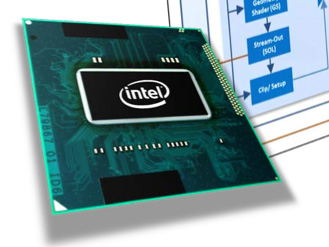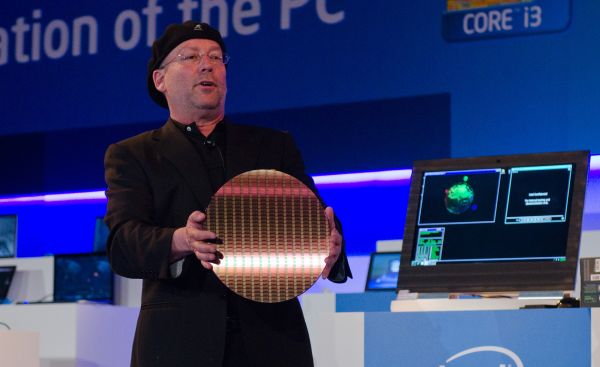Intel's Ivy Bridge Architecture Exposed
by Anand Lal Shimpi on September 17, 2011 2:00 AM EST- Posted in
- CPUs
- Intel
- Ivy Bridge
- IDF 2011
- Trade Shows
Five years ago Intel announced its ambitious tick-tock release cadence. We were doubtful that Intel could pull off such an aggressive schedule but with the exception of missing a few months here or there tick-tock has been a success. On years marked by a tick Intel introduces a new manufacturing process, while tock years keep manufacturing process the same and introduce a new microprocessor architecture. To date we've had three tocks (Conroe, Nehalem, Sandy Bridge) and two ticks (Penryn, Westmere). Sampling by the end of this year and shipping in the first half of next year will be Intel's third tick: Ivy Bridge.

Ivy Bridge (IVB) is the first chip to use Intel's 22nm tri-gate transistors, which will help scale frequency and reduce power consumption. As we already mentioned, mobile Ivy Bridge will be the first Intel CPU to bring four cores into a 35W TDP.
At a high level Ivy Bridge looks a lot like Sandy Bridge. It's still a monolithic die that features an integrated GPU. The entire die is built at 22nm, continuing Intel's march towards truly addressing integrated graphics performance. Ivy Bridge won't get rid of the need for a discrete GPU but, like Sandy Bridge, it is a step in the right direction.

Intel hasn't announced die size but transistor count has increased to approximately 1.4 billion (layout). This is up from 1.16 billion in Sandy Bridge, a 20.7% increase. With perfect scaling a 22nm Sandy Bridge die would be 47.3% the size of a 32nm die. Even with the increase in transistor count, it's a good bet that Ivy Bridge will be noticeably smaller than Sandy Bridge.
Motherboard & Chipset Support
Ivy Bridge is backwards compatible with existing LGA-1155 motherboards, although there will be a new chipset for Ivy Bridge and new motherboards to enable some features (e.g. PCI Express 3.0, native USB 3.0). The new chipset family falls under the 7-series banner. We'll see Z77, Z75, H77, Q77, Q75 and B75 available at or around launch.
| Chipset Comparison | ||||||||
| Z77 | Z75 | H77 | Z68 | P67 | H67 | |||
| CPU Support |
IVB LGA-1155 |
IVB LGA-1155 |
IVB LGA-1155 |
SNB/IVB LGA-1155 |
SNB/IVB LGA-1155 |
SNB/IVB LGA-1155 |
||
| CPU Overclocking | Yes | Yes | No | Yes | Yes | No | ||
| CPU PCIe Config |
1 x16 or 2 x8 or 1 x8 + 2 x4 PCIe 3.0 |
1 x16 or 2 x8 PCIe 3.0 |
1 x16 PCIe 3.0 |
1 x16 or 2 x8 or 1 x8 + 2 x4 PCIe 3.0 |
1 x16 or 2 x8 PCIe 3.0 |
1 x16 PCIe 3.0 | ||
| Processor Graphics Support | Yes | Yes | Yes | Yes | No | Yes | ||
| Intel SRT (SSD caching) | Yes | No | Yes | Yes | No | No | ||
| RAID Support | Yes | Yes | Yes | Yes | Yes | Yes | ||
| USB 2.0 Ports (3.0) | 14 (4) | 14 (4) | 14 (4) | 14 | 14 | 14 | ||
| SATA Total (Max Number of 6Gbps Ports) | 6 (2) | 6 (2) | 6 (2) | 6 (2) | 6 (2) | 6 (2) | ||
| PCIe Lanes | 8 (5GT/s) | 8 (5GT/s) | 8 (5GT/s) | 8 (5GT/s) | 8 (5GT/s) | 8 (5GT/s) | ||
As I mentioned above, Ivy Bridge finally supports USB 3.0 natively. The consumer 7-series chipsets feature 14 total USB ports, 4 of which are USB 3.0 capable. The CPU itself features 16 PCIe (1x16, 2x8 or 1x8 + 2x4) gen 3 lanes to be used for graphics and/or high performance IO. You will only see Gen 3 speeds on qualified motherboards. It's technically possible on 6-series motherboards but guaranteed on 7-series motherboards. The Z77 and H77 chipsets will support Intel's Smart Response Technology (SRT, aka SSD caching) which is a Z68 exclusive today.
SATA and chipset-attached PCIe slots haven't changed. Overclocking is supported on all Z-chipsets, while the H-chipset doesn't. All chipsets support Intel's HD Graphics, which is a departure from the Sandy Bridge mess where P67 didn't.










97 Comments
View All Comments
AstroGuardian - Monday, September 19, 2011 - link
"Intel implied that upward scalability was a key goal of the Ivy Bridge GPU design, perhaps we will see that happen in 2013."No we wont. The world ends in 2012 remember?
JonnyDough - Monday, September 19, 2011 - link
It ended in the year 2000. Hello! Y2K ring any bells? Come on, keep up with current events would ya?TheRyuu - Monday, September 19, 2011 - link
"I've complained in the past about the lack of free transcoding applications (e.g. Handbrake, x264) that support Quick Sync. I suspect things will be better upon Ivy Bridge's arrival."As long as Intel doesn't expose the Quick Sync API there is no way for such applications to make use of it, not to mention the technical limitations.
There are hints on doom9 that they know a bit about the lower level details but that it's all NDA'ed. Even with that knowledge he says that it's probably not possible or probable to do so.
You can find various rambling/rage here:
http://forum.doom9.org/showthread.php?t=156761 (Dark_Shikari and pengvado are the x264 devs).
tl;dr: http://forum.doom9.org/showthread.php?p=1511469#po... (to the end of the thread)
fic2 - Monday, September 19, 2011 - link
I would also wonder who (software wise) would be willing to put a lot of resources into supporting something that isn't really available on most SB platforms - or at least not available without jumping through hoops (correct mb, correct chip, 3rd party software, etc).fic2 - Monday, September 19, 2011 - link
"By the time Ivy Bridge arrives however, AMD will have already taken another step forward with Trinity."I wonder how realistic this is considering that AMD can't even get Bulldozer out the door.
My money is on Ivy Bridge showing up before Trinity.
Beenthere - Monday, September 19, 2011 - link
Considering Trinity was shown at IDF up and running and the fact that Trinity and other AMD nex gen products were developed concurrently with Zambezi and Opteron Bulldozer chips - which have been shipping by the tens of thousands already, I'd say Trinity will be here in Q1 '12.fic2 - Monday, September 19, 2011 - link
"Opteron Bulldozer chips - which have been shipping by the tens of thousands already"And, yet, nobody can benchmark them.
I hope that I am wrong, but given AMD's continual delays shipping the desktop BD I am not holding my breath.
Whichever comes first gets my money - assuming that BD is actually competitive with SB performance.
thebeastie - Tuesday, September 20, 2011 - link
You talk about what's for support for handbrake but to put it harshly your mind is stuck in the past gen device era.I simply grab a full DVD and run makemkv on it to just store it unmodified in a single file and copy it to my iPad2 directly.
Plays perfectly fine under avplayerhd.
I consider it that you would have to be insane as in you think your an onion to bother handbrakin your videos if you got a device like ipad2 that can just play them straight.
If your the hoarder type that insists that you watch Rambo 4 etc every week and need to pack 100+ full movies on your single device at the same time your a freak so pipe you niche life style comments to /dev/null.
I would not understand why you have time to bother shrinking/ converting your movies all the time over just getting sick of some of them and putting new stuff on from time to time.
TheRyuu - Tuesday, September 20, 2011 - link
8.5GB for a movie seems a bit impractical for an ipad.thebeastie - Wednesday, September 21, 2011 - link
Full 8gb is big but they still copy of amazingly quickly over to a ipad2 64gb, a lot of DVDs don't get that full size anyway.If you bought a honeycomb tablet and put sdslot storage on it, I am sure it would be a extremely painfull slow copying experience if you use SD over built in flash, maybe this is what Apple avoid sd lslotd in the first place. Built in flash is lighting fast and less draw on battery.
Having full on pc and just coying over in 2mins vs bothering to convert I know what i just choose full copy every time.
Once I have watched it takes at least a year before I consider watching the same thing again.